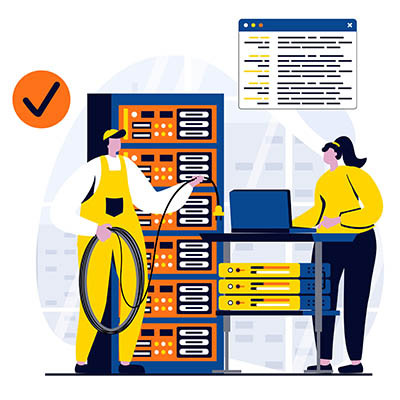When it comes to cybersecurity, the most important aspect is often pushed aside in favor of solutions that are easier to control, like firewalls, encryption, and modern detection and response tools. However, the biggest and perhaps most important factor affecting your business’ security is, in fact, its people. No matter who you are, it only takes one accidental click to send your network spiraling into chaos, and even the most well-intentioned employees can wreak havoc under the right circumstances.
PC PLACE Blog
AI has revolutionized the way businesses operate, streamlining various tasks and changing how knowledge-based businesses function in record time. One of the ways that businesses are using AI is customer support, but how effective is it really? Is there any merit to maintaining the human element of your customer service, or said in a different way, what can human customer support offer that AI cannot?
All businesses need a little IT assistance from time to time, whether it’s for a simple hiccup some software or a full-blown technology emergency. Cybercriminals will often pose as IT support in attempts to capture this low-hanging fruit. Your employees should know how to spot the following warning signs from a fraudulent tech support squad.
A successful business is a secure business. You probably have a good lock on the front door, maybe an alarm system, and secure cabinets for important documents. You do all of this to protect your business' physical assets from threats. So why wouldn't you do the same for your digital assets?
Just as you have physical security measures, your business also needs strong cybersecurity policies. They help create clear rules for employees to follow and a plan to fall back on if an incident occurs.
There’s a lot of comfort to be found in familiarity. It’s why so many of us cling to the way we’ve always done things. It’s the root of the old adage, “if it ain’t broke, don’t fix it.” In many contexts, this can be very good advice. One place it isn’t: your business’ technology.
Neglecting to improve the technology your business relies on can itself incur significant inherent costs that aren’t immediately apparent. Let’s explore them to truly appreciate the benefits of keeping your business’ tech up to date.
As a business owner, you wear many hats. You're the CEO, the head of sales, the marketing guru, and often, the de facto IT department. It's understandable that with so much to do, dealing with a sluggish computer or a temperamental software program gets pushed to the bottom of the to-do list. A laissez-faire attitude towards your technology can have serious consequences, however. Today, we’ll go through why being lazy with your IT causes more harm than good.
Many—we’d go so far as to say most, at some times—businesses have a pretty concrete view of the role that their IT plays in operations: cost center, money pit, necessary evil.
Something we’ve realized, however, is that these impressions are simply warning signs that a business’ technology strategy and approach need some attention. Let’s identify three signs that might be all too familiar to you, and address what can be done to change course and help turn your IT into a contributing part of your overall productivity.
Deals are great, aren’t they? Offering some money and getting more than you’d expect in return… It’s the next best thing to free. It’s also really nice to get something fast.
Not so fast, though. As nice as they can make things seem, “cheap” and “quick” aren’t often synonymous with “effective” or “valuable.” In fact, selecting the presumably easy route regarding your business technology can ultimately lead to bigger problems in the form of something called tech debt.
Running a small or medium-sized business means juggling countless priorities. You're focused on your customers, team, and bottom line… but what about the technology that powers it all?
Often overlooked, your IT infrastructure is far more than just the computers on desks. It's the complex web of network equipment, essential software subscriptions, cloud services, and even the personal smartphones and tablets your employees use for work. Keeping this entire ecosystem running smoothly and securely is a significant challenge for many SMBs.
It is great to have pride and confidence in your business, especially in the team you’ve assembled… including your in-house technical support team. That said, even the most capable IT team may not fully meet a business’ needs.
Let’s explore why this is and what can be done to correct any deficits your team may encounter.
If I were to ask you what technology your business possessed and where it all was right now, could you give me an answer? If not, you’ve demonstrated the importance of keeping an accurate inventory of your business’ IT.
So, let’s go over some best practices to make managing your business’ IT inventory more effective.
Do you ever feel at home in your business’ server room? That is, assuming you have a server room, and it’s more than just a stuffy closet in an isolated part of your office. If you’re not confident that you can provide your servers with the management, maintenance, and monitoring they need, we recommend you work with a managed IT company to ensure you get the most value you can from your server units.
The big thing in business computing is AI, or artificial intelligence, and businesses are implementing it to solve a lot of repetitive problems that free up their employees to serve other roles. One such area is for IT support. But is it worth it to chat with a robot when something as important as IT is on the line?
Computer problems can be super frustrating, especially when they slow you down while working. Many times, it is something that can be fixed quickly, but then there are issues that an experienced IT professional has to address. Let’s take a look at some of the most common computer problems professionals run into.
It’s natural for businesses to rely on their tools, like IT, to achieve success, but if you don’t take care of your systems, it could lead to downtime. You can bypass many of these challenges with the right approach to technology maintenance. We want to highlight some of the proactive methods you can use to keep downtime to a minimum.
Managing servers can be a challenging task for small and medium-sized businesses (SMBs). Despite being essential to your operations, servers are complex technologies that, if not managed properly, can lead to wasted time, energy, and resources. Today, we’ll explore the key functions of server management and how to maximize your current resources.




















